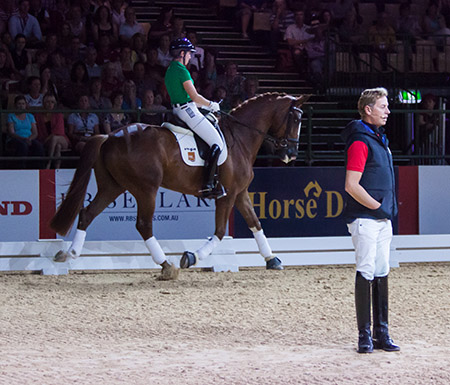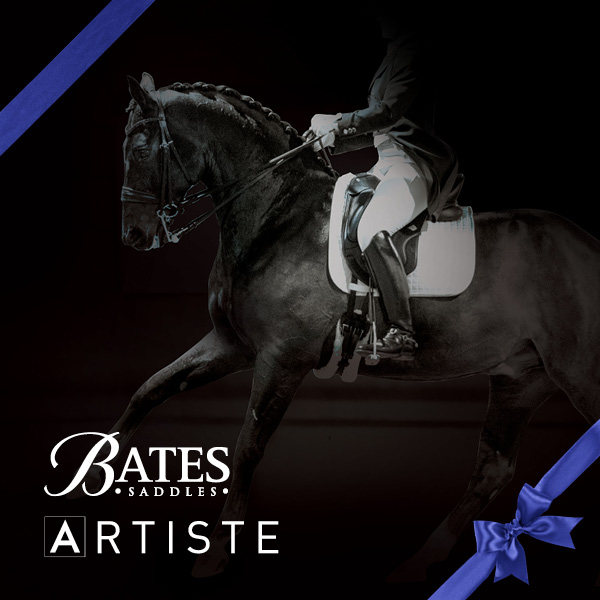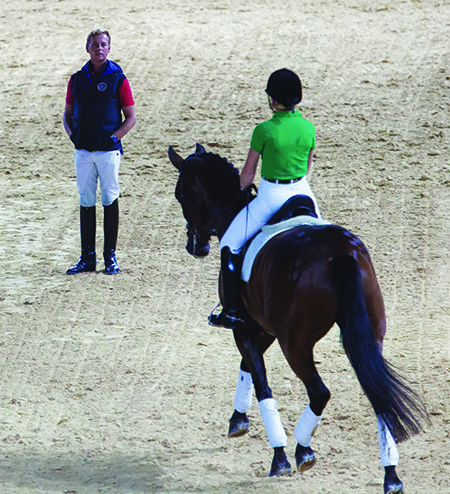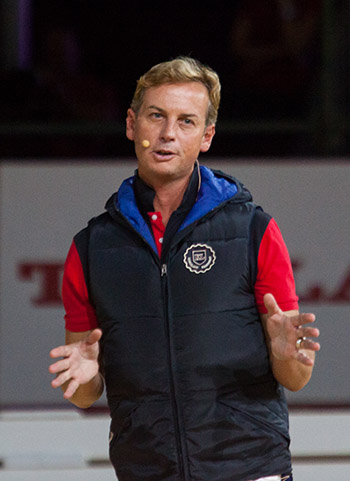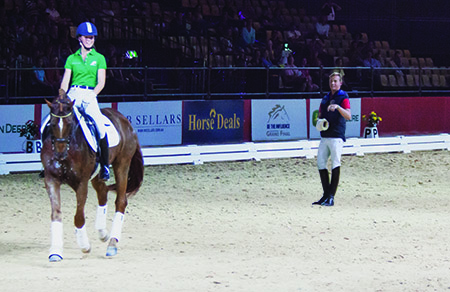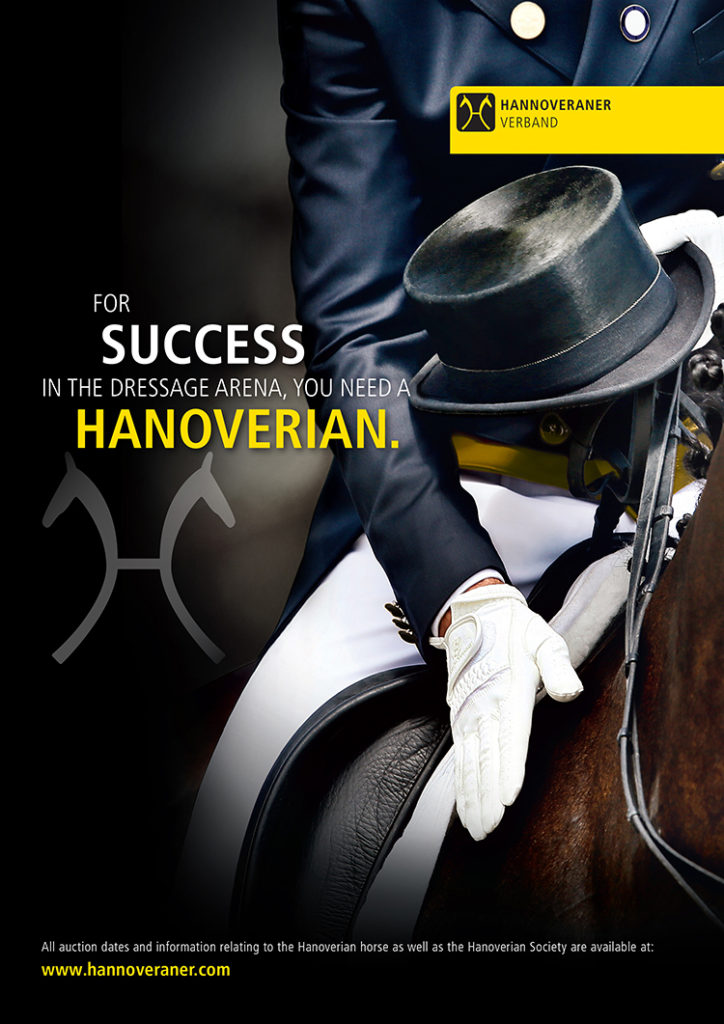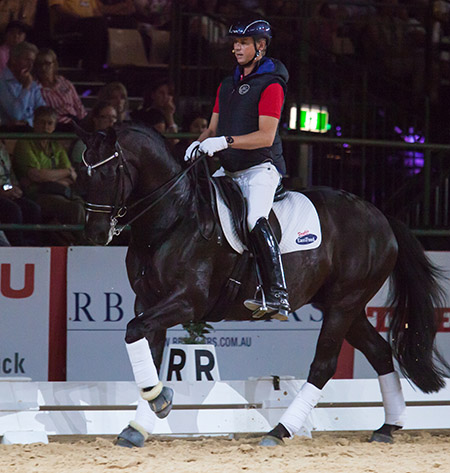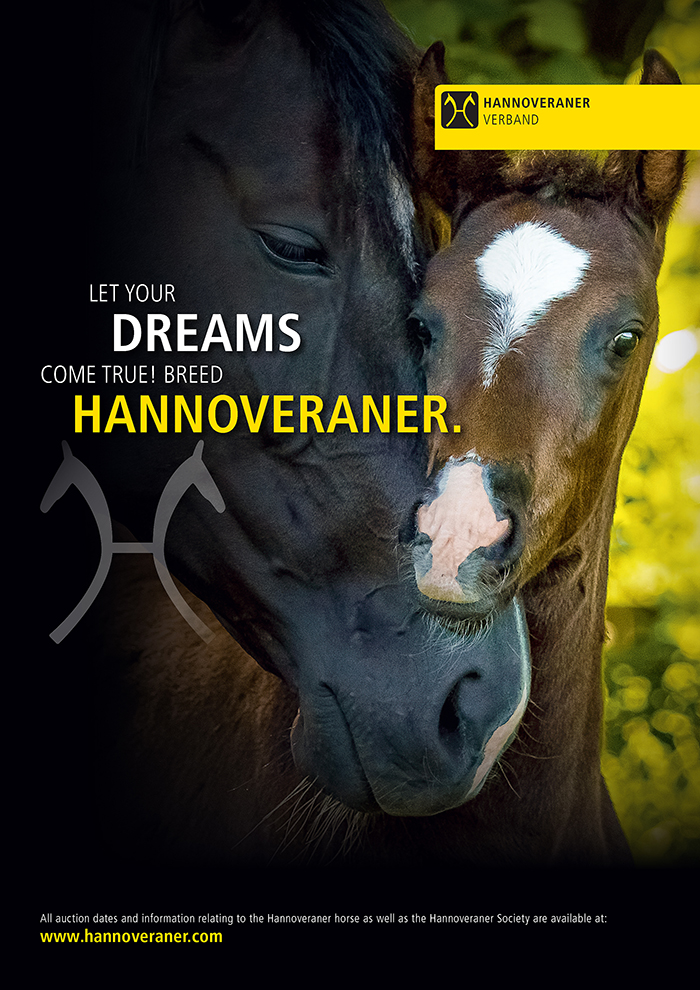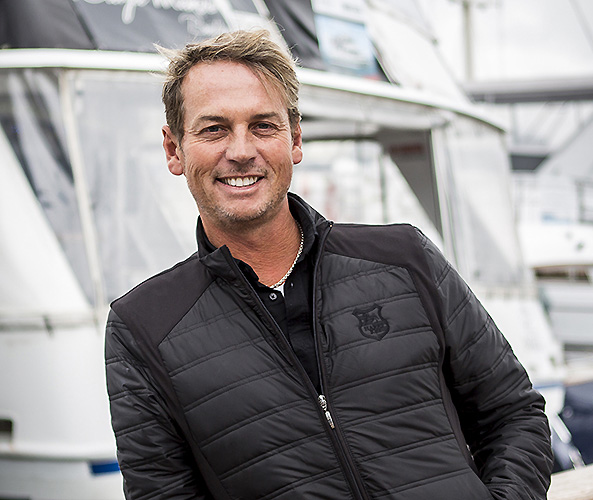
Half way through his masterclass at Equitana, Olympic dressage gold medalist and all-round nice guy Carl Hester remarked, “I never thought a Brit would be able to help the Australians. I’m quite enjoying it actually!” And help us he most certainly did, with the flair and good humour he’s become famous for.
Carl, with the help of some impressive Aussie riders and horses, took the audience on an express trip through the dressage levels, beginning with what to look for in a dressage horse through to Grand Prix.
First off the blocks was Kate Taylor-Wheat and her super cute Flowervale Florenz. Although not so eager to enter the spooky atmosphere to begin with, the chestnut gelding enjoyed a positive learning experience.
As Kate settled Florenz, Carl explained what he looks for when looking at a prospect, “First thing I look at when I buy a horse is paces rather than breeding. Beautiful parents don’t always produce beautiful children. I’m not looking for the flashiest paces, but also the trainablility and rideability. How are you going to keep a big, flamboyant mover sound into Grand Prix? You want an easy mover. This horse has the first thing on the scale of training: rhythm.”
Kate had to keep her horse quite together and forward at the start. “Kate is quite rightly thinking of safety first. But now we want to look at where he puts his head and neck as he relaxes and becomes more rideable. Always work for relaxation. Then with more stretch his hind leg will be good. Does he look happy? I think he’s looking quite jolly. Kate, show me a rising trot and lengthen the rein,” requested Carl.
It was important that all the horses in the clinic were very easy in their stretching and Carl emphasized how important the warmup is. His horses do about half an hour of hacking and stretching before either he or Charlotte get in the saddle. When Florenz wasn’t stretching, Carl explained further, “He’s curling over away from your hand at the moment. He needs to stretch more. Look behind the saddle at what the tail’s doing. The tail will come up and swing side to side and the back will lift up. Your hand has to come more forward towards his ear, not down, and his neck has to come more out. I want him to unlock himself. I don’t want the flashy movement at this stage. But he shouldn’t curl over and disappear, the body should lengthen and you shouldn’t try to hold the whole thing together.”
Next came leg yielding, and Carl wanted it done in rising trot:
“Let him feel like he doesn’t have to carry the rider and do the movement. If his quarters lead, he loses his balance. He fell out because you didn’t control it and let him run sideways. This is why dressage riders love mirrors. The little details and changes make a big difference. You don’t teach the horse to move off your leg by moving its head. You teach it from your leg. You did that well. Kate can feel when it’s right or wrong.”
more from Carl follows
“Now he stretches better because he works up on the bit. Such a different stretch than in the beginning. You don’t do one round and stop thinking oh I’ve made it. Look how the muscles are now moving in his neck and back. This is a good place to finish.”
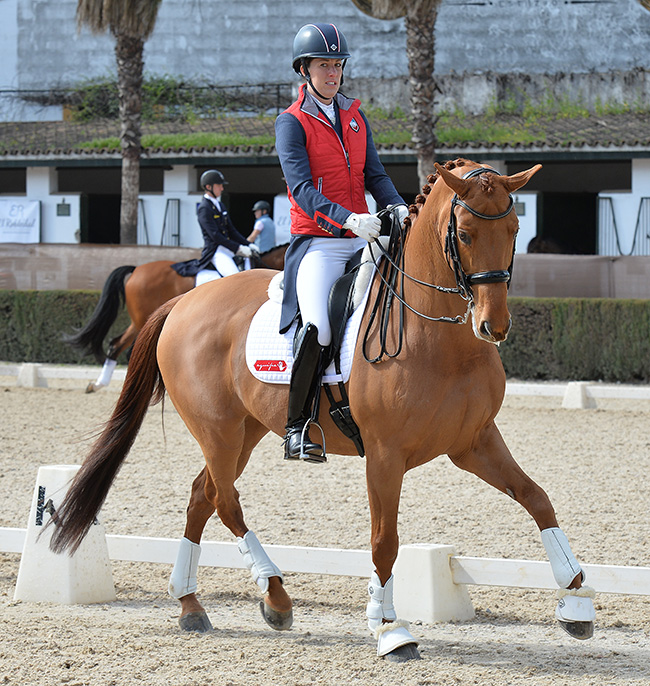
Charlotte and Barolo demonstrate what Carl is talking about for us…
Linda Foster’s elementary level Neversfelde Samiro impressed Carl from the start with his super trot, “This is a beautiful horse. Do you know what I like? I like that I can’t hear it on the floor. The hind legs are active and under him”.
Linda then tried the canter, “At the moment he’s a bit up and down with the shoulders in the canter. He needs more reach. Although the trot is good, he’s on the forehand in the canter. Sorry, Linda, no more trot! He needs to be in a more uphill frame. Make the canter small enough so you’re thinking pirouette so he starts sitting. Look low down to the inside hind leg. He should sink here in the fetlock. Look there and not so much the front of the horse. He needs to let down in that fetlock much more.”
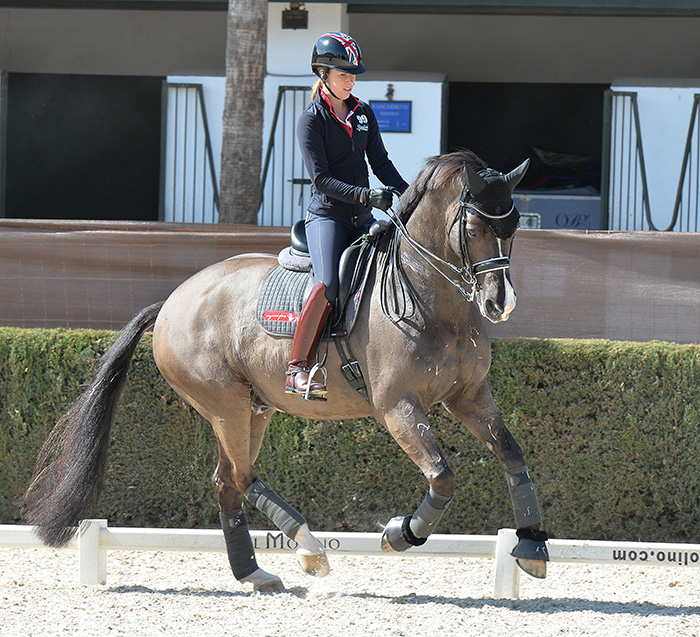
Charlotte and Valegro show uphill canter
Carl suggested that 70-80% of Linda’s training with this horse should be at the canter as the trot was not getting him stronger.
The next focus was on lightness. “Is that your giving?” enquired the Englishman, “In England we say that’s a Scottish give, ‘cause we all know what the Scottish are like! You’re elegant with a good position, but the horse should be more on your seat and less on your hand. Don’t give everything away when you ride forward. Keep him uphill. At this point you must not override. I’d rather see the horse do a mistake. If you’re working this hard now, there’s going to be a hell of a lot of sweat at Grand Prix!”
An exercise to help the horse engage and sit better was leg yield at the canter. Still Carl wanted more sitting, “It was obedient, but not sitting. If you want scores of 70% and above, you need both.”
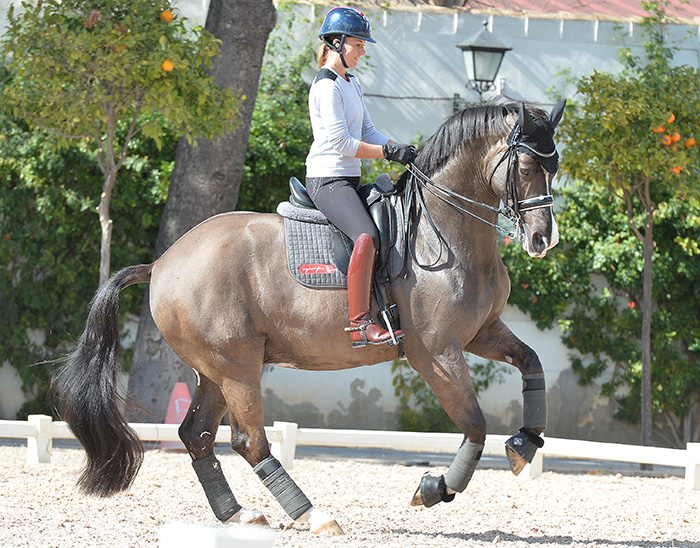
A sitting pirouette
The risk of mistakes was not a problem and Carl acknowledged how long it can take to get to Grand Prix and the difficulties one can encounter on the way, “If you’re a one horse owner, you know how frustrating it can be if things don’t go well. It can ruin your life, ruin your marriage. But you have to know it’s not always easy.”
Like most of the horses Carl worked with, things started to improve. The horse came lighter on the bit. However, there was still more work for Linda and it was time to tackle control in the corners as Carl explained a helpful exercise:
“Trot up to a corner and halt before it. You have to ride the corners not just free wheel around. This is a good waiting exercise. He has to let you in and let you ride him. This is rideability. Now see if you can ride him around your leg in the corner and it doesn’t feel like the wall of death. You should be looking for his inside eye, but not over flexing.”
Like the previous horse this combination finished with a long, stretching trot. “This is your basic stuff. You should be able to stretch him without him running forward.”
next, Lisa Martin and First Famous
Next was Lisa Martin and First Famous. Carl was taken with the stunning mare’s athleticism; regular, engaged with a super shoulder movement, but warned that Grand Prix was a long way off. He also sympathised with us Aussies being so far away, “It’s very promising here at the moment in the lower levels. It must be very difficult living down here. You really do have to go away and train and see ‘out there’”.
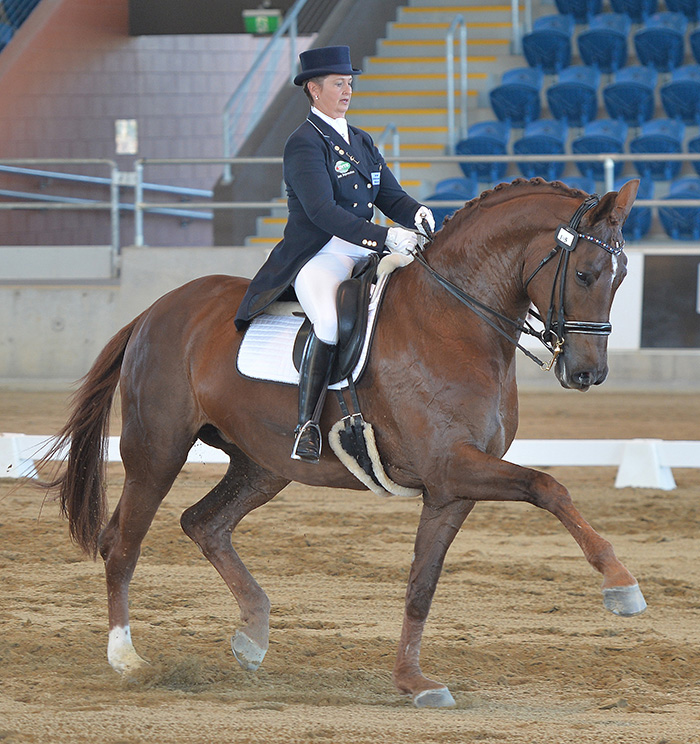
Lisa and First Famous out competing
It was straight into the movements with Carl reminding that each movement should have; preparation, then maintaining the movement and then riding out of it and around the corner.
When the mare showed a difference on each rein in the shoulder in, Lisa was asked to ride up the centre line, “You need to get control of the right side of the horse. You drifted about a metre to the left. Not too drunk, but a bit! You need to ride shoulder in with no bend because you’re worrying too much about the bend and it’s causing the neck to tip and twist. On the other rein, the horse is more naturally in her curve.”
When it came to travers, Lisa needed to create the angle more with her leg. The exercises, when executed correctly, improved the suppleness of the horse and hence the expression. There was then a warning about neck reining so as not to tilt the mare’s head and instead the rider was encouraged to stand up and step down through her inside stirrup more.
Here was another horse who wanted to run in the stretching trot. Carl was quick to correct and suggested having eyes on the ground as much as possible, “You have to remember every day to do these corrections and not slip back into habits.”
There was just enough time to give the flying changes a go. The horse had only tried them a few times before so Carl went into detail about how hard it is for young horses, and how it probably wouldn’t happen, “The mare is not good at it yet because she’s young. Yesterday one was flying without change, one was a bit of a buck. There were a few variations, but I want Lisa to show you what’s happening in the training right now.”
But with the horse’s superior balance and willing temperament, she offered two perfect changes. “Ah well there you go. She proved me wrong,” Carl conceded with a grin.
The first of the FEI horses was Rombali Razzamatazz with Robbie Soster in the saddle. Carl explained what the main problem was in the warm-up session, “Robbie and the horse are a little bit nervous about taking the contact. She goes shoulder in everywhere, but she needs to be straight so the horse can move forward. I can honestly say, hand-on-heart that straightness is the hardest thing. At least she’s consistently crooked! The horse is in travers left all the time so she rides shoulder in left all the time. If he’s not straight, he can’t carry himself forward and push forward properly.”
Carl was worried about the horse’s slow passage. “This horse is good at sitting but not so good at pushing. At Grand Prix, you need both. Some horses are usually better at one than the other.”
“Let’s get him trotting behind first and try a quicker passage. It’s a different passage, not a Grand Prix passage, but it makes the horse think that it’s got to go forward and move its hind legs more. He has to be on the bit and not like a banana in his back. He must lift his back, but at the moment he’s not on the bit. Instead of sitting there like a fairy on a tree, do something about it, don’t just keep going.”
Robbie had to get the horse relaxed at the higher tempo, then regular passage could be developed. If she just rode the slow passage all the time, problems were sure to develop. Then Robbie was asked to develop the collected trot without losing the suspension she was beginning to create. The horse had to work harder, and Robbie less, “Don’t work so hard! You shouldn’t get off your horse and need to be stretchered away”.
It was a similar message with the one tempi changes. It wasn’t just about getting the movement, but also quality in the movement. “Does he need to learn how to do one-times changes? No, he needs to learn to be straight and jump forward with the hind legs. Let the wall do the work.”
This was a positive change from the previous day Carl told us, “Yesterday she was doing the fastest, highest one-time changes I’d ever seen in my life. I take my hat off to her because she was determined to get them, but now she has to work on the quality. Do this and you’ll be a Grand Prix winner.”
next Carl rides
It was then Carl’s turn to throw a leg over a horse and his mount was Susan Duddy’s DP Weltmieser, Brett Parbery’s Grand Prix ride. Carl was perhaps a bit nervous at the task ahead, “The fact that he’s hot is making me hot! I haven’t ridden and talked for years.”
He began the gelding with a lot of walk/ halt transitions, often halting after one stride of walk, just to feel the control and then it was straight into canter, “Christ, he is hot!”.
Then Carl tried some leg yield in the trot, “This is actually good because it’s making me put my leg on. When they’re hot, you tend not to put the leg on.”
It wasn’t too long before the horse was rewarded with a walk, “If I keep going with these hot horses, then the body gets tired but the brain keeps buzzing so you’re always working a little bit against them.”
Back into the canter again and Carl gave us a lesson in knowing your strides. “How many of you actually know how many strides you ride on the short side? Most of my horses would do between 9-11 steps. I know in a test situation when I’m showing more quality, I’ll go for nine strides. For example, when I canter onto the short side and know I have to do a flying change at A, I know to do the change on the fourth stride. I can make it a positive aid then and not be wondering where the letters are.”
Even though he was hot, he was wanting to back off. In the halt where the gelding wanted to drop the contact, so the problem was addressed quickly so as not to become a habit.
Carl finished on a positive note, “This is actually the kind of horse I like to ride. That’s enough. I have to ride again tonight. Now I have a nice relaxed feeling. I don’t need to go on and show off.”
Last horse into the arena was Lauries As and Tor Van Den Berge. Carl liked the horse’s presence, but warned of ‘stallion issues’, “Breeding stallions need concentration. You know what they’re really thinking about! The other thing is that sometimes they can get sore backs. You have to really think about working the horse soft in his back.”
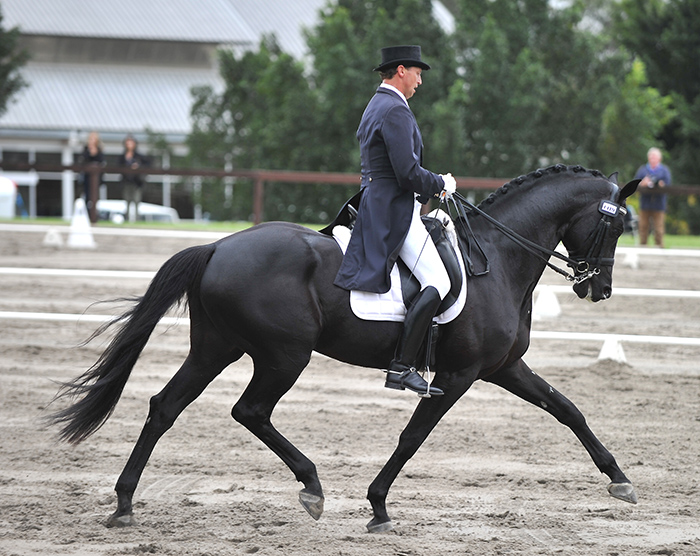
Tor van den Berge and Lauries As
The focus for this combination was the canter zig zag, and Carl had some interesting exercises.
“Leg yield in canter is for the hotter horse. It’s more relaxing. We do this instead of half passes or zig zag half passes at home. So Tor I want you to canter on the right lead, leg yield, think shoulder in and then flying change. These sorts of exercises stop the anticipation.”
Next the exercise was repeated, but in half pass. Then the difficulty was increased, “Now four lots of six, but only four of the strides are sideways.”
When Tor gave it a go, he missed it because he lost control. “The horse moves more easily to the left so he goes further to the left than the right,” so back to leg yield.
more detail follows
“It’s not all about doing Grand Prix. If you get your horse to Grand Prix at eight years of age, what are you going to do for the next 10 years? It bores most of us, what’s it going to do to them? Hacking, hill work and giving them different exercises like this helps them keep it.”
Lauries As moved on to work in the passage and, the leg yield was introduced once more, “Move the bit and let go. Don’t hold. Looser reins. He’s a stallion and they do get strong in the neck. Leg yield in passage and that will stop him pulling forward. You can let him trail a little bit. He needs to come over and not push away from you.”
There was difficulty in getting a good piaffe/ passage transition, and Carl had a good exercise, “So, to get from passage to piaffe, teach him to do one step of piaffe and then out again. He needs to get stronger in the transition, so doing loads of passage won’t help.”
His final message? “I’d never want to say you should do it my way or I’m right. Just try to find the ability to ride a horse in self carriage.”
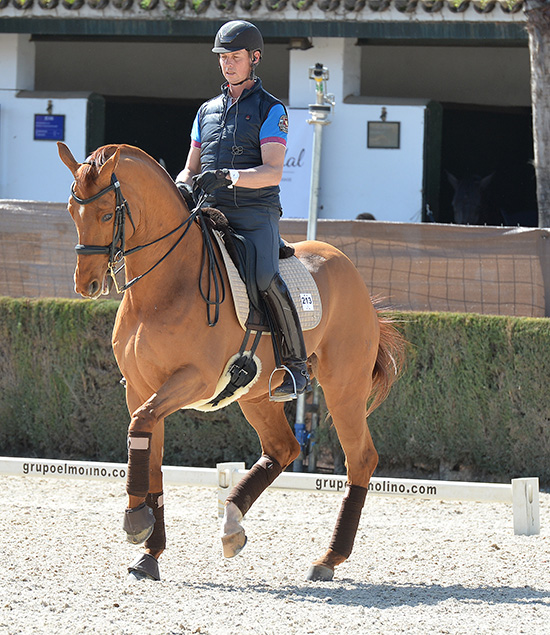
Breeding your own dressage star? There’s a range of top European bloodlines available right here in Australia, go to www.ihb.com.au and choose the right one for your mare.
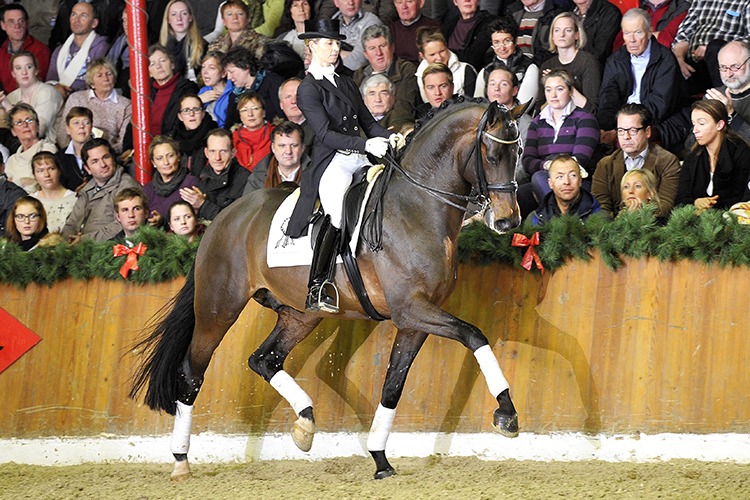
Bordeaux
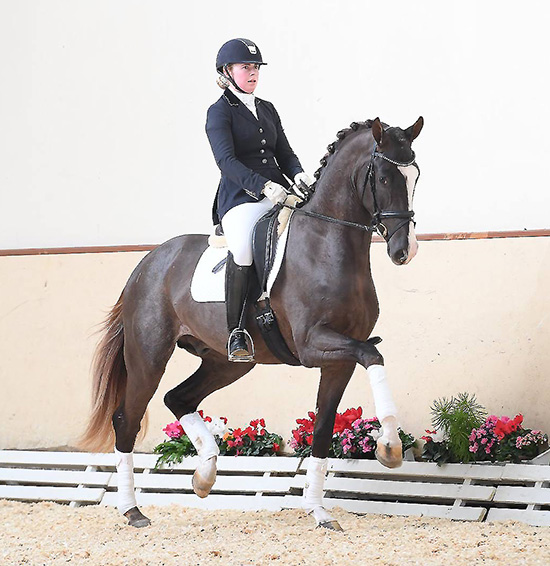
Sezuan’s Donnerhall




